Key Takeaways
- It is recommended that 10% to 35% of total daily calories come from protein. (1)
- Getting 25 to 30 grams of protein in one sitting is considered a high-protein meal.
- A high-protein diet can enhance immune function, oxygen transport, blood sugar balance, diabetes management, energy, muscle growth, and satiety. (2)
- Good sources of high-protein foods include lean meats, fish, soy, and dairy products. (3)
The best way to hit your macros might be to engage in an hour or two of food prep on Sunday, but let’s be honest — this doesn’t always happen. As much as we all hope for a break on the weekend, it may be just as chaotic and action-packed as the Monday-to-Friday grind.
If keeping diligent track of your macros and getting enough protein is important for your goals, you need a Plan B to keep you on track once the weekly crush begins anew. And let’s face it — even shakes made from the best protein powders don’t always cut it. Here, we’ve put together some of the best easy, high-protein weeknight recipes for you. Some of the recipes come directly from certified nutrition coach Sari Terranova, and they’ve all got the information you need to choose the best meal for you — and impressive taste profiles, to boot.
Easy Weeknight Meals With Over 25 Grams of Protein
Keeping a reasonably well-stocked pantry and some lean protein and veggie options in the freezer dramatically increases the average human’s chances of making healthy choices. Research shows that eating more frequently at home, regardless of your goals, leads to healthier outcomes. (4)(5) Even so, sometimes we all have to have the “we have food at home” talk with ourselves.
These recipes are quick and easy, perfect for those weeknights when you are too tired to cook an elaborate meal for yourself and the family. Still, they’re packed with enough protein — and tastiness — to fuel your performance in and out of the gym. Half are plant-based, and you can modify pretty much all of them to be vegan or vegetarian as desired. All of them feature flavor and variety with simple, minimally processed, and convenient products. You’ll also find a balance of the big three macronutrients: protein, carbs, and fats.
Need to know how much protein you need to begin with? Our protein intake calculator can help as you dive into these recipes.
- Beef Taco Bowls
- Lazy Tuna Arrabbiata (AKA Spicy Italian Tuna)
- Buffalo Chicken Baked Potatoes
- Pork Fried Rice
- Vegan Sausage, Greens, and White Beans
- Air Fried Tofu Nuggets with Broccoli and Peanut Sauce
- Lentil Curry
- Walnut and Lentil Tacos
- Chickpea Salad (With Tempeh Bacon) Sandwich
- Seitan Banh Mi
- White Bean, Sundried Tomato, and Broccoli Rotini
- Pesto Chickpea Pasta Salad
- Salmon Over Rice
- Choose-Your-Own-Protein Sandwich
- Cobb Salad
- Raspberry Balsamic Chicken and Kale Salad
- Chicken, Broccoli, and Sundried Tomato Pasta
- Turkey, Cheese, and Hummus Plate
- Air-Fried Salmon and Chard
- Sausage and Fennel Chickpea Pasta
Beef Taco Bowls
Tacos are incredibly versatile and allow you to manipulate macros very easily. If you want a lower-carb option for your performance goals, swap the rice for a couple of corn tortillas (saving about 20 grams of carbs). Easily increase the protein by adding more beef or additional toppings such as shredded cheese or beans.
For convenience, this recipe calls for taco seasoning. But if you have a decently-stocked spice rack, you can avoid the extra potential sodium bloat by making your own with chili powder, cumin, garlic powder, oregano, and a little cayenne pepper.
Macros Per Serving
- 475 calories
- 33g protein
- 43g carbs
- 17g fat
Ingredients
- 5-ounce 93% lean ground beef
- 1 tablespoon low-sodium taco seasoning mix, or make your own
- ½ cup salsa
- 2 cups lettuce, chopped
- ½ cup frozen microwavable white rice, prepared
- ¼ of an avocado, diced
- ½ cups prepared pico de gallo
- 1 tablespoon light sour cream
Directions
Brown ground beef in a saute pan over medium-high heat. Add seasonings and salsa. Simmer until reduced to preferred thickness. To assemble, add beef mixture, salsa, lettuce, cooked rice, avocado, pico de gallo, and sour cream to a large bowl. Add additional toppings as desired.
Lazy Tuna Arrabbiata (AKA Spicy Italian Tuna)
This Roman-inspired dish is destined to become a weeknight staple. It is equally delicious with pre-cooked chicken sausages — but the sodium count on those bad boys can be astronomical, so take heed.
To cut the carbs, you can opt for zoodles, or even add some in with the pasta for an added veggie burst and volume boost. You can opt here for a tablespoon of extra virgin olive oil for flavor and satiety. However, if you’re interested, you can eliminate 119 calories and almost 14 grams of fat by eliminating the oil and just using cooking spray.
Macros Per Serving
- 532 calories
- 38g protein
- 58g carbs
- 16g fat
Ingredients
- 1 tablespoon extra virgin olive oil (note: using cooking spray eliminates 119 calories and almost 14 grams of fat)
- 1 clove garlic, crushed (or a dash of garlic powder added with the other spices)
- 1 (5-ounce) can tuna in water, drained (low sodium preferred)
- 1 cup tomato puree
- ½ cup water
- 1 teaspoon red pepper flakes, or to taste
- 1 teaspoon dried oregano
- 1 cup cooked, thin spaghetti or any pasta of your choice
Directions
Heat oil in a saute pan over medium heat. Add garlic and cook until fragrant (about a minute). Toss in the tuna and saute for another minute. Add puree, water, and herbs/spices. Simmer for about five minutes and fold in your cooked pasta.
Buffalo Chicken Baked Potatoes
The humble potato is really a dynamic hero, transforming itself into almost endless variations of satiating deliciousness.
Although oft-vilified by waves of anti-carb diet frenzy, the potato is an easily digestible source of energy. The potato boasts substantial servings of potassium, iron, magnesium, folate, and vitamins C and B6, with a little fiber and protein to boot. It is warm. It is filling. And it goes with everything.
Macros Per Serving
- 425 calories
- 34g protein
- 31g carbs
- 19g fat
Ingredients
- 1 medium russet potato
- 1 teaspoon butter
- 4-ounce rotisserie chicken, shredded
- 1 ounce crumbled feta cheese
- 2 cups baby arugula
- Hot sauce to taste
Directions
Pierce the potato several times with a fork. Place in a 400-degree oven for 45 to 60 minutes or microwave for seven to 10 minutes, turning the potato halfway through cooking time. When a fork goes into the potato easily in the thickest part, it is done.
Cut open the potato and fluff up the interior with a fork, season, and mix in butter. Place a bed of arugula on a plate and top with chicken, feta, and hot sauce. Serve on the side or on top of the potato.
Pork Fried Rice
When the craving for take-out hits, remember that you can make this dish in less time than it takes for a delivery service to drop off an over-priced version of it. You can add whatever veggies you have on hand and can make it even simpler by using a store-bought stir fry sauce. Just remember to check the label for added sugars and sodium if that’s a concern for you.
If carbs don’t sit well with you, sub frozen veggie “rice” for the white rice. In that case, use a tablespoon less water in the sauce, as cauliflower and other veggies excrete excess liquid.
Macros Per Serving
- 539 calories
- 34g protein
- 44g carbs
- 25g fat
Ingredients
- ½ tablespoon sesame oil
- 4-ounce lean boneless porkchop, cubed
- ¼ cup onion, chopped
- ¾ cup frozen microwavable white rice, prepared
- 2 cups chopped baby spinach
- 1 large egg, scrambled
For the sauce:
- 1 tablespoon low-sodium soy sauce or coconut aminos
- 2 tablespoon water
- ½ tablespoon sesame oil
- Fresh or ground ginger to taste
- Optional: sliced green onions, red pepper flakes, sriracha
Directions
Heat oil in a saute pan over medium high heat. Add pork and onions. Stir fry until pork is browned and almost cooked though. Add rice, spinach, and sauce, tossing to coat. Make an empty spot in the center of the pan and pour in the egg. Scramble until cooked though and fold into the rest of the ingredients in the pan. Top with sliced green onions and hot pepper flakes or a dash of sriracha if you like it spicy.
Vegan Sausage, Greens, and White Beans
If meatless is your jam, this Tuscan-inspired dish may be your new weeknight go-to. It is simple to make multiple servings at once and save for lunch or dinner the next day.
You can sub any greens for the chard; broccoli rabe is more time consuming to prepare, but is a complementary accompaniment. Cannellini beans — or white beans — will turn to mush if you add them too early in the process, so be sure to gently fold them in at the end of preparation to preserve the texture and bite of this delicate, buttery legume.
Macros Per Serving
- 581 calories
- 37g protein
- 25g carbs
- 38g fat
Ingredients
- 1 tablespoon extra virgin olive oil, halved
- 2 links Italian vegan sausage
- 1 clove garlic
- 1 bunch Swiss chard
- ¼ cup cannellini beans, drained and rinsed
Directions
Pan-fry the sausage links in ½ tablespoon of oil over medium heat until crisp and heated through. Remove from the pan and set aside. Add the remaining oil and garlic to the pan and saute for 30 seconds. Add Swiss chard and saute for two to three minutes, adding a little water if necessary to soften the chard.
When the chard is cooked through, gently fold in the beans until just heated through. Slice the sausages and serve alongside the greens and beans.
[Related: Best Vegan Protein Powders]
Air Fried Tofu Nuggets with Broccoli and Peanut Sauce
OK, so hear us out. It looks like there are a lot of ingredients here, but really this one’s all about shaking and baking — erm, air frying. You’ll be tossing a lot of spices in, which accounts for the somewhat hefty ingredient list. But no need to be intimidated — this is super simple (and delicious). If the fat content from the peanut sauce is too high, you can swap out with simple salt and pepper to taste for the broccoli.
Macros Per Serving
- 394 calories
- 25g protein
- 28g carbs
- 22g fat
Ingredients
- 16 ounces extra firm tofu
- 3 tablespoons cornstarch
- 3 tablespoons nutritional yeast
- ½ teaspoon garlic powder
- ½ teaspoon onion powder
- 1 tablespoon sesame seeds
- 2 ½ tablespoons low-sodium soy sauce
- 1 tablespoon sesame oil
- 1 medium yellow onion
- 2 cups broccoli florets
- Salt to taste
For the sauce:
- ¼ cup unsalted peanut butter
- 1-2 teaspoons of hot sauce (to taste)
- 1-2 tablespoons low-sodium soy sauce (to taste)
- 2-3 tablespoons of water (to preferred texture)
- 1-2 tablespoons crushed peanuts (to preferred texture)
Directions
Put a pot of water on to boil before prepping your other ingredients. Press your tofu in a tofu press or wrapped in a clean towel under a heavy book for 10 minutes. While it’s pressing, mix the cornstarch, nutritional yeast, garlic powder, onion powder, and sesame seeds in a large bowl. When the water boils, put in the broccoli to soften it.
When the tofu is pressed, cut it into one-inch cubes and cover each piece in the soy sauce. Roll each piece in your dry mixture, then pop them in a single layer in the air fryer at 480 degrees for 5-7 minutes. Start sauteeing your onions in a tablespoon of sesame oil. Add salt to taste (remember there will be more salt from the sauce).
In a small bowl, mix your sauce ingredients — sans the crushed peanuts — until it’s smooth. Add the boiled broccoli to your onion sautee along with your sauce. Serve with crushed peanuts on top.
Lentil Curry
You can’t go wrong with a good curry, and this one will keep you full for hours — and will keep well in the fridge, just marinating and getting better over time. You can adjust the spices as desired or according to what you have available. And if you need something a little less high in fat content, you can swap out the almond butter. Just remember that it also is adding protein (and creamy goodness) to the plate.
Macros Per Serving
- 706 calories
- 25g protein
- 59g carbs
- 45g fat
Ingredients
- 1 tablespoon extra virgin olive oil
- 4 cloves garlic
- 1 teaspoon tumeric
- 1 teaspoon cumin
- ½ teaspoon coriander
- 1 teaspoon chili powder
- 2 teaspoons curry powder
- 1 teaspoon garam masala
- 2 cups of filtered water
- 1 cup dry red lentils
- 14-ounce can crushed tomatoes
- 13.5-ounce can coconut milk
- 3 tablespoons unsweetened almond butter
- Salt and pepper to taste
Directions
Rinse your lentils in cold water in a strainer. Heat the olive oil in a large skillet while you chop the garlic cloves. When the oil has a bit of a sizzle to it (you can toss in a drop of water to test), add the garlic, stirring frequently as it starts to become fragrant. Add your spices, lowering the heat and stirring frequently so they don’t burn. Pour in the water, followed by the lentils and crushed tomatoes.
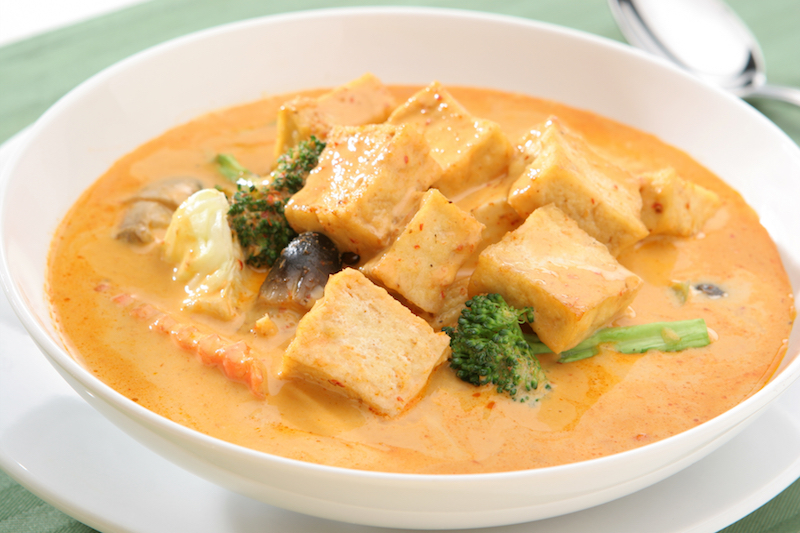
Stir well, then cover and let simmer for 25 minutes. Add the almond butter, coconut oil, and salt and pepper to taste. Mix well, and let it continue to simmer if the lentils aren’t soft yet. Serve over rice, roti, or another delicious carb of your choice.
[Related: How Much Protein Do You Actually Need Per Day?]
Walnut and Lentil Tacos
Who says tacos have to have meat to be fun (and delicious)? These choose-your-own-adventure tacos replace meat with high-protein plant-based goodness. Note: because everyone makes their tacos so differently, do some quick math to add the macros for whatever cheese you might add, whether you’re using flour or corn tortillas, and the salsa or guacamole you choose. The nutritional information below focuses just on the lentil and walnut “meat.”
Macros Per Serving
- 382 calories
- 22g protein
- 44g carbs
- 14g fat
Ingredients
- 1 medium yellow onion
- 1 cup dry red lentils
- ½ cup walnuts
- 4 tablespoons nutritional yeast
- 1 ½ tablespoon chili powder
- ½ teaspoon garlic powder
- ½ teaspoon onion powder
- ½ teaspoon oregano
- 1 ½ teaspoons cumin
- ½ teaspoon paprika
- ½ teaspoon chipotle powder (or to taste)
- 1 teaspoon sea salt (or to taste)
Directions
Rinse your lentils in a strainer with cold water, then add them to a pot of water. Bring the water and lentils to a boil and let them simmer for 15-20 minutes. In the meantime, prepare your favorite taco ingredients — perhaps dice some tomatoes, shred some lettuce, and prepare cheese, salsa, and guac.
Toss all the other ingredients into a food processor. When the lentils are soft, drain them well. Put them into the food processor and pulse until the ingredients are blended. The mixture should be loose but stick together fairly well. Combine in your tacos as desired and enjoy.
Chickpea Salad (With Tempeh Bacon) Sandwich
No need for eggs here, but it’s still packed with high-protein foods. All you’ll need is a food processor and a couple slices of your favorite bread (we’re recommending ciabatta). This chickpea salad sandwich is meant to bring you all the fun — and protein! — of egg salad sandwiches, except without the…well, eggs. This plant-based high-protein recipe packs a delicious, protein-filled punch, especially with the tempeh bacon. You can use canned or dry chickpeas for this one, but our recipe is calling for canned because it’ll be a whole lot faster for a weekday night.
Macros Per Serving
- 533 calories
- 29g protein
- 26g carbs
- 50g fat
Ingredients
- 1 ½ cups cooked chickpeas
- 2 ½ tablespoons tahini
- 1 teaspoon Dijon mustard
- 2 tablespoons fresh cilantro
- 2 tablespoons lemon juice
- ½ garlic clove
- 1 teaspoon capers
- 3 tablespoons nutritional yeast
- 1 teaspoon paprika
- 1 teaspoon soy sauce
- 1 tablespoon maple syrup
- ¼ teaspoon salt
- ½-1 teaspoon liquid smoke (to taste)
- 2 tablespoons extra virgin olive oil
- 8 ounces tempeh
- Sliced ciabatta
Directions
Toss all ingredients down to and including the nutritional yeast into a food processor. Pulse until the mixture comes together. Add some water if you need it to be a bit more moist, but it should hold together alright. In a small bowl, mix the paprika, soy sauce, maple syrup, salt, and liquid smoke. In a pan, heat the olive oil.
Thinly slice an 8-ounce package of tempeh. Put each slice of tempeh into the pan in its own space. As it begins to brown on the bottom, brush the liquid smoke and spice mixture onto each slice. Turn to cook on the other side until both are golden brown. Assemble your sandwich on ciabatta, adding tomatoes and other sandwich fixings as desired.
Seitan Banh Mi
Born of Vietnamese ingenuity and adaptability in the face of French colonialism, a banh mi combines Vietnamese flavor palates with French baguettes. Coming across vegan and vegetarian banh mi is quite common — and in this recipe, we’re going to work with seitan. You can also opt for tofu or tempeh, but since seitan generally comes prepped (unless you make it from scratch), it’s pretty simple — and delicious —to toss together on a busy weeknight.
Macros Per Serving
- 552 calories
- 30g protein
- 68g carbs
- 16g fat
Ingredients
- ¼ cup matchstick carrots
- ¼ cup matchstick daikon radish
- ½ cup rice vinegar
For the seitan marinade:
- ½ cup soy sauce
- ¼ cup rice vinegar
- 1 teaspoon sweet chili sauce
- 10-ounces seitan
- ⅓ cup vegan mayonnaise
- 1 teaspoon lemon
- ½ cucumber (sliced)
- 1 large jalapeño (sliced)
- ⅓ cup cilantro (chopped)
- 2 baguettes
Directions
Mix your carrots and daikon radishes into the rice vinegar. Let is sit for 20 minutes, occasionally stirring. Mix your soy sauce, smaller portion of rice vinegar, and sweet chili sauce. Add your seitan and let marinate for 10 minutes. When everything is marinated, assemble your sandwiches with all the ingredients, to taste.
White Bean, Sundried Tomato, and Broccoli Rotini
This one has a simple sauce and an even simpler set of instructions. All you’ve got to do is boil your pasta, add your broccoli, and sautee some onions. You really haven’t got to worry about protein content, either — at 30 grams per serving, you’ve got a pretty whopping amount going, especially for a plant-based dish.
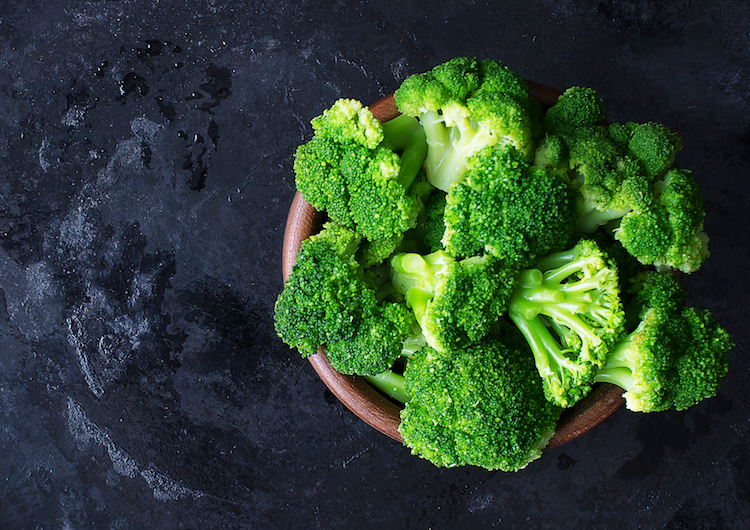
You can easily swap in lentil pasta for the chickpea pasta, too — and it doesn’t have to be rotinin, either (we chose it because the shape lets as much sauce as possible seep into each bite). This won’t take you long at all — so sit back and wait for the water to boil (because that’s pretty much all you’ll have to do).
Macros Per Serving
- 494 calories
- 30g protein
- 78g carbs
- 12g fat
Ingredients
- 8 ounces chickpea rotini
- 1 medium yellow onion
- 15.5-ounce can white beans
- 2 cups broccoli florets
- 1 cup sundried tomatoes
- 2 tablespoons olive oil
- 3 tablespoons nutritional yeast
- 1 teaspoon lemon juice
- Salt and pepper to taste
Directions
Bring a large pot of water to a boil with a pinch of salt in it. When it’s boiling, add your pasta and your broccoli florets. Boil until the pasta and broccoli are at the level of softness you desire. While it’s boiling, sautee your onion in olive oil, adding a bit of salt to taste. Add your white beans and chopped sundried tomatoes once your onions start becoming fragrant and translucent. Drain the pasta and broccoli and combine, coating everything with the olive oil, nutritional yeast, lemon juice, and salt and pepper to taste.
Pesto Chickpea Pasta Salad
Once again, we’re going with chickpea pasta — nothing against carbs (they’re so good), but this kind of pasta is very protein-forward, which is what we’re going for here. You can also use lentil pasta, but we’ve found that chickpea pasta tends to be much better left over, whereas lentil pasta can get a bit dry in the fridge. The biggest labor here will be making your pesto, but all you’ll need is a food processor or strong blender — and it’s literally as easy as tossing everything in and pressing the on button.
Macros Per Serving
- 540 calories
- 24g protein
- 55g carbs
- 29g fat
Ingredients
- 8 ounces chickpea penne
- ½ medium red onion
- ½ cup corn
- ½ cup green peas
- 1 cup white beans
- 2 cups fresh basil
- ¼ cup olive oil
- 2 tablespoons nutritional yeast
- 1-2 tablespoons lemon juice
- ½ cup pine nuts
- Salt and pepper to taste
Directions
Bring a pot of water to boil with a pinch of salt. Add your chickpea penne when it’s boiling. In the meantime, chop your red onion into small pieces. Put your basil, olive oil, nutritional yeast, lemon juice, and pine nuts (can substitute walnuts or cashews), along with salt and pepper to taste, into a food processor or strong blender. Blend until smooth. Strain the penne and rinse with cold water. Add your veggies and white beans, and toss with the pesto.
Salmon Over Rice
You’re in luck on a busy night — this recipe only calls for one non-stick skillet. You’ll minimize clean-up and maximine protein intake (not to mention taste!) all at the same time. And isn’t that the dream? Make sure you’re cooking the salmon all the way through for food safety reasons and opt for sustainable seafood sources whenever possible.
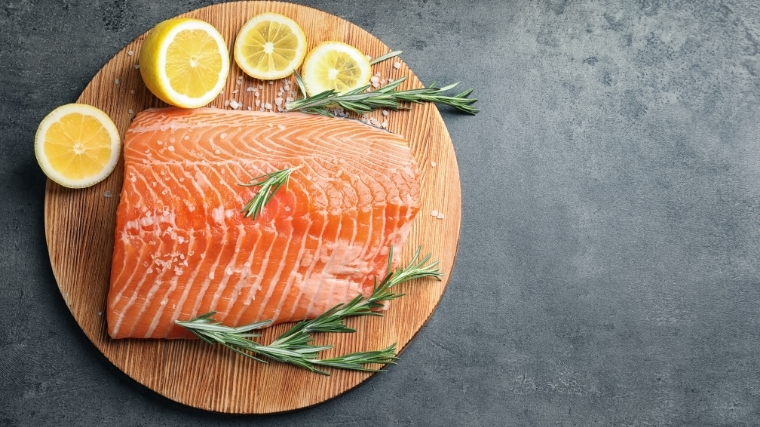
You can add whatever veggies you’d like to this mix — we recommend chopped onions and bell peppers in the recipe, but you can slice and dice however you please. It’ll change the macros a bit, but you’ll still be getting your veggies in.
Macros Per Serving
- 551 calories
- 41g protein
- 68g carbs
- 11g fat
Ingredients
- 4 salmon fillets
- 1 teaspoon salt
- 1 large yellow onion
- 1 medium orange bell pepper
- 1 medium red bell pepper
- 4 cloves garlic
- 1 teaspoon paprika
- 1 teaspoon tumeric
- Salt and pepper to taste
- 3 cups low-sodium vegetable broth
- 1 lemon juice
- 1 ½ cups rice (rinsed and drained)
Directions
Season both sides of the salmon with salt. In a large non-stick skillet, heat a tablespoon olive oil over medium-high heat. When the oil is hot, put the salmon fillets with the skin side down. Sear for a couple of minutes per side. This isn’t meant to cook it through — that will come soon. Set the salmon aside on a plate.
Reduce the heat in the same skillet and add the remaining 2 tablespoons of olive oil. Cook the onion until translucent, then add the chopped bell peppers. Once they’re a bit softer, add the minced garlic and continue until fragrant. Add the rice, paprika, turmeric, and salt and pepper to taste. Keep stirring for a couple minutes. Add the vegetable broth. Simmer the mixture.
Add the salmon fillets on top, then cover the skillet. Cook on low heat for about 20 minutes. Check that the rice is cooked all the way through and the salmon is nice and flaky. Add lemon juice and enjoy while it’s warm.
Choose-Your-Own-Protein Sandwich
There’s almost nothing easier to prepare than a sandwich, especially if you’re using deli meats and pre-sliced cheeses (both, of course, are available in vegan versions). You can also opt to cook up some homemade tempeh bacon (featured above in the chickpea salad sandwich recipe).
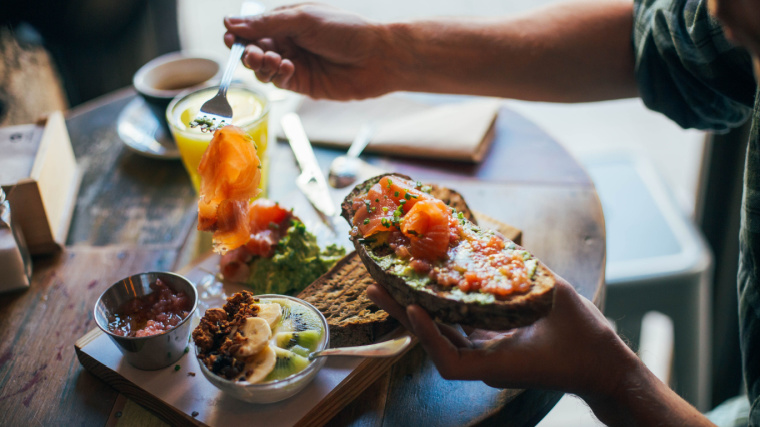
However you decide to assemble your sandwich, make sure you’re emphasizing the protein.
Macros Per Serving
- 641 calories
- 31g protein
- 94g carbs
- 16g fat
- Your macros here depend on your ingredient selection. Check the packages and grab your calculator for some simple addition. The macros presented here are for the specific ingredients included below, which may serve 2 to 3 people with some leftovers.
Ingredients
- 8 ounces tempeh bacon
- 2 medium tomatoes
- ½ cup spinach
- ½ cup microgreens
- ½ medium red onion
- ½ cup black olives
- ½ large cucumber
- 1-2 teaspoons Dijon mustard
- 2 baguettes
Directions
Slice your bread and toast if desired. Assemble the ingredients onto your sandwich, adding drier ingredients (like spinach) directly to the bread before wetter ingredients (like tomatoes) to avoid sogginess. Eat, and enjoy.
Cobb Salad
This one’s a classic for a reason, but it’s not your average salad — between the bacon, chicken, and blue cheese, this is a quick, filling salad that will have you hitting your protein intake goals in no time. Vegans can easily swap in tofu, tempeh bacon, and vegan chicken, though it will change the macros profile accordingly. To get less calories and fat in there, you can also opt for less dressing or sub in extra virgin olive oil (which will still be high in those things, just less so than the dressing).
Macros Per Serving
- 745 calories
- 42g protein
- 14g carbs
- 57g fat
Ingredients
- 8 slices bacon
- 4 eggs
- 3.5 cups chopped, cooked chicken
- 1 head shredded iceberg lettuce
- 2 large tomatoes
- 1 cup blue cheese
- 3 green onions
- 1 large avocado
- 8 ounces Ranch dressing
Directions
Bring your eggs to a boil. Let them cool for 10 minutes or so. Cook your bacon thoroughly in a non-stick skillet for about 7 minutes. Slice up the bacon and eggs, along with the tomatoes, green onions, and avocado. Combine all ingredients into your salad bowl. Mix thoroughly, or keep ingredients in their own separate sections as desired.
Raspberry Balsamic Chicken and Kale Salad
Raspberry and…chicken? Yes. Yes indeed. You’ll get the savory elements you’re looking for, accompanied by the sweetness and tartness of the raspberry jam or preserves. You’ll be adding balsamic vinegar, too, which will act like a glaze and will round out the overall flavor profile. And don’t worry — the kale part of the kale salad needn’t be rough and fibrous. Massaging it in olive oil will take care of that, so you’ll just be able to enjoy.
Macros Per Serving
- 533 calories
- 38g protein
- 65g carbs
- 12g fat
Ingredients
- 2 bunches kale
- 2 tablespoons olive oil
- 3 boneless chicken breasts
- 1 teaspoon salt
- 1 teaspoon onion powder
- 1 teaspoon garlic powder
- 1 cup seedless raspberry jam or preserves
- ¼ cup balsamic vinegar
- 1 teaspoon black pepper
Directions
In a large bowl, shred your kale into manageable pieces. Massage with olive oil with your hands and let it sit (sprinkle some salt if desired, too). Season the chicken all around with salt, onion powder, and garlic powder. Cook it until golden brown all over in a non-stick skillet, testing the internal temperature until it’s 165 degrees. In a small bowl, combine the raspberry jam or preserves with the balsamic vinegar and black pepper. Adjust ratio to taste. Put the chicken on the bed of kale salad, and cover with the raspberry vinaigrette.
Chicken, Broccoli, and Sundried Tomato Pasta
This one’s pretty much as simple as they come. You’re going to cook your chicken thoroughly, boil your broccoli alongside your pasta to give it that soft texture, and coat it all in a deceptively delicious olive oil and salt mix. It’s as simple as that, but it’ll be offering a delightful kick of brightness from sundried tomatoes, and packing a massive amount of protein.
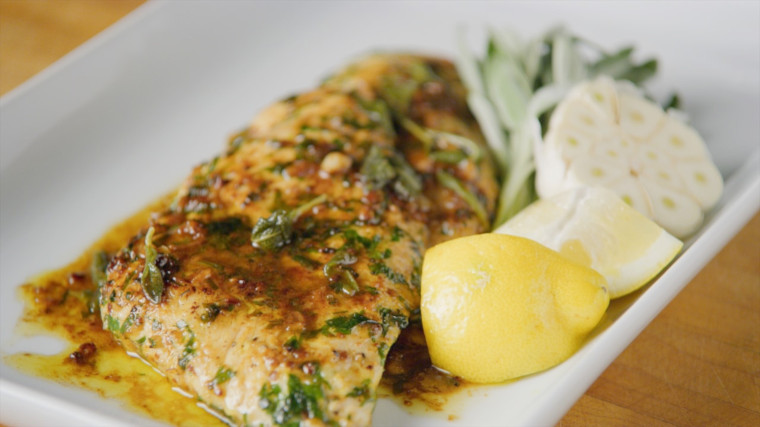
In this recipe, we’re using chickpea pasta for extra protein, but you can, of course, use wheat-based pasta, too. (You can also swap the chicken for vegan chicken!)
Macros Per Serving
- 458 calories
- 40g protein
- 41g carbs
- 17g fat
Ingredients
- 2 boneless chicken breasts
- 1 teaspoon salt
- 1 teaspoon garlic powder
- 1 teaspoon onion powder
- 3 tablespoons olive oil
- Salt to taste
- 8 ounces chickpea pasta
- 2 ounces sundried tomatoes
- 1 ½ cups broccoli florets
Directions
In a large pot, bring water to a boil with a pinch of salt. Add the pasta and broccoli when it gets to a boil, and cook until desired texture is achieved. While it’s cooking, season and cook the chicken in a non-stick skillet until it reaches an internal temperature of 165 degrees. Drain the pasta and broccoli. Top with chicken, sundried tomatoes, and olive oil with salt to taste.
Turkey, Cheese, and Hummus Plate
Don’t want to do any actual cooking? Good news — you don’t have to. Put together a quick and dirty charcuterie board, featuring high-protein snacks like turkey, cheese, and hummus. But really, you can arrange it any way you’d like, with any meats, cheeses, or vegan variations you care to sample. Rummage in your pantry for some optional dried apricots and jam, and you’re in business.
Macros Per Serving
- 458 calories
- 40g protein
- 41g carbs
- 17g fat
Ingredients
- 8 deli slices turkey
- 8 slices cheddar
- 2 ounces hummus
- 2 sliced apples
- ¾ cup baby carrots
- ½ cup dried apricots
- ¼ cup almonds
- ½ baguette
Directions
Assemble and slice all your ingredients as desired. Plate and serve.
Air-Fried Salmon and Chard
The air fryer isn’t just for French fries. You can also get a quick, protein-rich meal out of it. Here, you’ll be sauteeing some Swiss chard while the salmon air fries — which won’t take that long at all. The combination will have you full and sitting back, enjoying your muscle-building meal, in no time at all.
Macros Per Serving
- 458 calories
- 40g protein
- 41g carbs
- 17g fat
Ingredients
- 4 salmon fillets
- Salt and pepper to taste
- 1 ½ tablespoons extra virgin olive oil
- 2 tablespoons nutritional yeast
- 1 large bunch Swiss chard
- Chili oil to taste
Directions
Pre-heat the air fryer to 400 degrees. Season the salmon with salt and pepper to taste, and air fry with a half tablespoon of olive oil until it’s crispy and cooked (opaque) throughout. While it’s in the frier, remove the large stems from the Swiss chard to compost or add to another recipe.
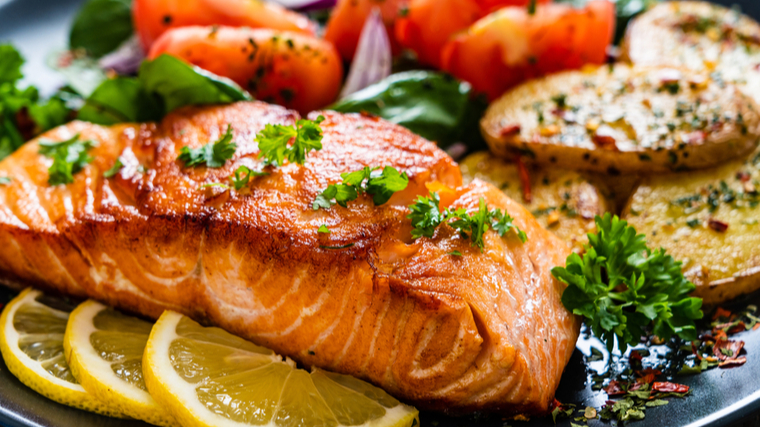
Add the rest of the olive oil to a non-stick pan and sautee the chard. Add the nutritional yeast, as well as salt and pepper to taste. Place the cooked salmon on the bed of greens and drizzle with chili oil to taste.
Sausage and Fennel Chickpea Pasta
Once again, we’re calling for chickpea pasta — and once again, you can opt for wheat varieties if you’d like. But since you came here looking for high-protein recipes, we figure you might not mind the less conventional option to get you what you need to fuel your hypertrophy goals. Regardless of the type of pasta you use, the sausage — whether vegan or not — and white beans will bring a solid amount of protein to this meal.
Macros Per Serving
- 467 calories
- 26g protein
- 68g carbs
- 15g fat
Ingredients
- 6 links sausage
- 1 tablespoon olive oil
- 8 ounces chickpea pasta
- ½ cup white beans
- 1 medium yellow onion
- 2 cups broccoli florets
- 2 ounces sundried tomatoes
- 1 tablespoon fennel
- Salt and pepper to taste
- 1 tablespoon sesame oil
Directions
Bring a large pot of water to boil with a pinch of salt. While it’s heating up, slice the sausage into small, circular pieces about a quarter to a half-inch thick. Coat a non-stick skillet with a tablespoon of olive oil over medium heat, and cook the sausages on both sides, all the way through.
While they’re cooking, chop the onion. Put the sausages aside, re-oil the pan, and add the chopped onion. Cook until fragrant and translucent. Add salt and pepper to taste, then add the sundried tomato, fennel, and white beans. Stir frequently. When the water boils, add the pasta and broccoli, cooking until they reach the desired texture. Drain and toss all ingredients together. Adjust salt and pepper to taste, and add sesame oil as a drizzle on top.
Macros 101
Macros, or macronutrients, are the most essential nutrients that the body needs in the largest amounts: protein, fats, and carbohydrates. Your body also needs many other nutrients such as vitamins, minerals, and fiber. So it is important that when you are fulfilling your daily macro goals, you opt for foods that are rich in these micronutrients as well. You can generally do this by focusing on whole, unprocessed, or minimally processed foods when possible.
Macros Ratio
The ratio of macros that one should consume is highly specific to the individual’s body composition goals, metabolism, activity level, and other factors. Some athletes might find that their body runs optimally, builds muscle, and maintains their desired fat ratio best when they allocate an equal split of 35 percent of their daily calories to protein and carbs, and the remaining 30 percent to fats.
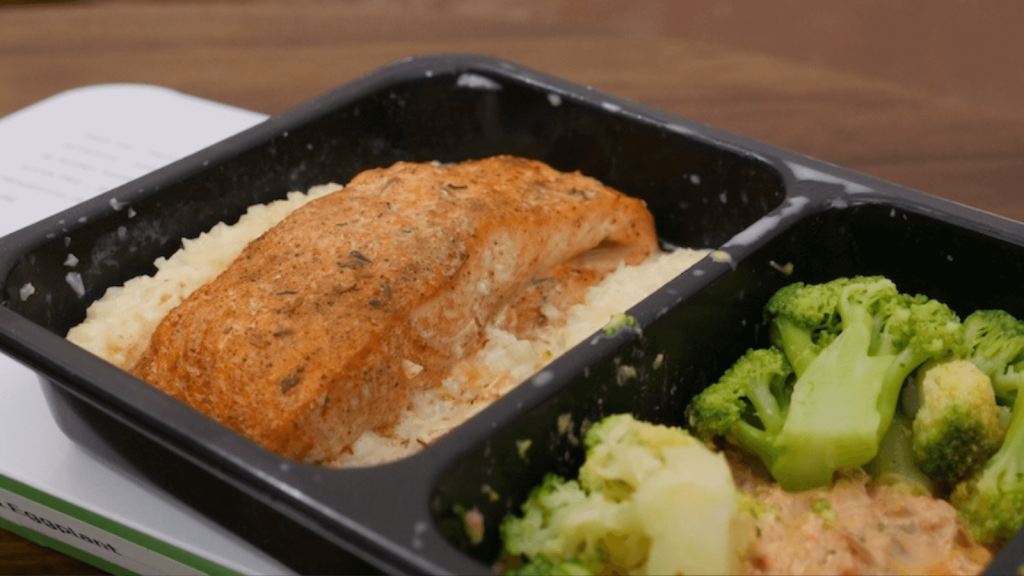
Your macros may vary during different periods of your training cycle, as you age, or even as your priorities and goals shift.
Since you’re probably reading this because you’re specifically concerned about your protein levels, check out BarBend’s protein intake calculator to get the info you need.
Protein Intake Calculator
Getting Your Macros
Keeping macros in check doesn’t have to be complicated. Tweaking your regular shopping list, staying well-stocked with essentials, and having these simple protein-centered recipes under your belt will open up a whole new world of weeknight culinary delights.
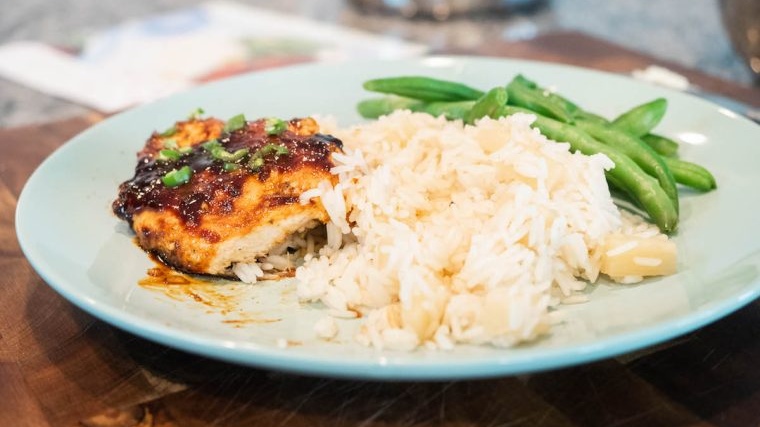
Not sure what an ideal macros ratio is for you? Check out BarBend’s macros calculator* to help get you on the right track.
Macronutrient Calculator
*Check out the note above regarding our protein intake calculator for how trans and nonbinary athletes can navigate the gender options on both calculators.
General High-Protein Recipe Tips
With each dish, you should spray your pan with cooking spray as needed (if you avoid nonstick cookware, this step is crucial) and season with salt and pepper to taste as you go.
You can easily substitute a different protein or whatever veggies you have on hand in a given recipe. Maybe you have ground turkey that you need to use up in your taco bowls instead of beef. If you are not a fan of tuna but want a tasty seafood dish, toss a frozen codfish filet into the arrabbiata sauce while it simmers. Prefer beef fried rice? Use flank steak instead. Just remember to adjust your macros accordingly.
What Counts as a “High Protein” Meal?
Although the myth that one cannot efficiently utilize more than 30 grams of protein at a sitting has been largely debunked, it is still generally accepted that 25 to 30 grams is a good benchmark for a high-protein meal, assuming your goal is to consume the recommended 1.6 to 2.2 grams per kilogram of body weight per day to build muscle. (3) Can you go higher if your body needs it? Absolutely.
Lean Protein Favorites
If you build your meal around a protein source rather than starting with a starch, you are more likely to get the balance of macros that you seek. When food prep doesn’t make it into the schedule, it is essential to have protein sources available in the kitchen so you can make dishes like these on the fly.
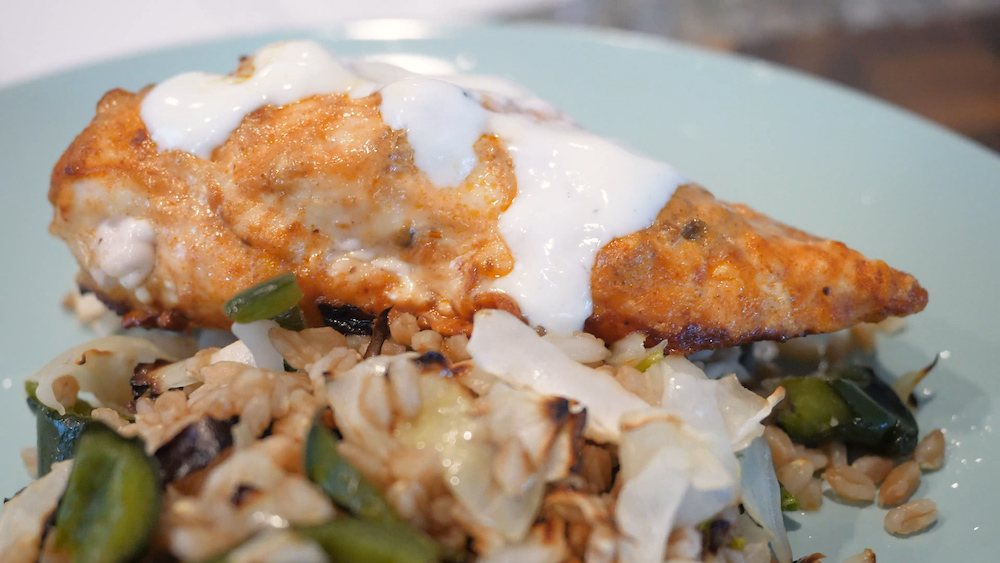
Keeping a freezer or fridge stocked with tofu, beans, or lean cuts of poultry, beef, pork, and seafood ensures that you always have an essential cornerstone of a meal at hand.
[Related: High-Protein, Low-Calorie Foods]
Boneless, skinless chicken breast, ground chicken or turkey breast, pork tenderloin, lean ground beef, eye of round or top sirloin steak, pork tenderloin, and tofu are all fantastic lean protein sources lend themselves well to a variety of preparations. Frozen wild fish, such as salmon, is quick and easy to prepare (you can pop it into the air fryer frozen and it’s done within 20 minutes) and will often fulfill your protein and healthy fats quota in one delicious filet.
Side Dish Staples
A well-stocked freezer and pantry make building a balanced meal around a protein a breeze. Pre-cooked frozen rice or other grains, frozen veggies that hold their texture well, such as Brussels sprouts and asparagus, and vegan protein sources, such as frozen meat substitutes and legumes, make chaotic weeknights easy to conquer and protect you from that wilted produce walk-of-shame to the garbage can.
Canned tuna, beans, and pasta can be cooked and tossed together in under 15 minutes. Couscous cooks in a snap and is delicious with just a hint of olive oil and a squeeze of lemon. A handful of pumpkin seeds can add protein, magnesium, and healthy fats to a salad topped with chicken or a vegan quinoa bowl. Find your favorite go-to sides and always have them at the ready.
Sneaky Sodium
You know that feeling the day after a meal out on the town when it feels like your pants shrunk in the wash? Contrary to popular belief, you didn’t gain five pounds from eating your body weight in pad Thai overnight — but sodium will make you feel that way.
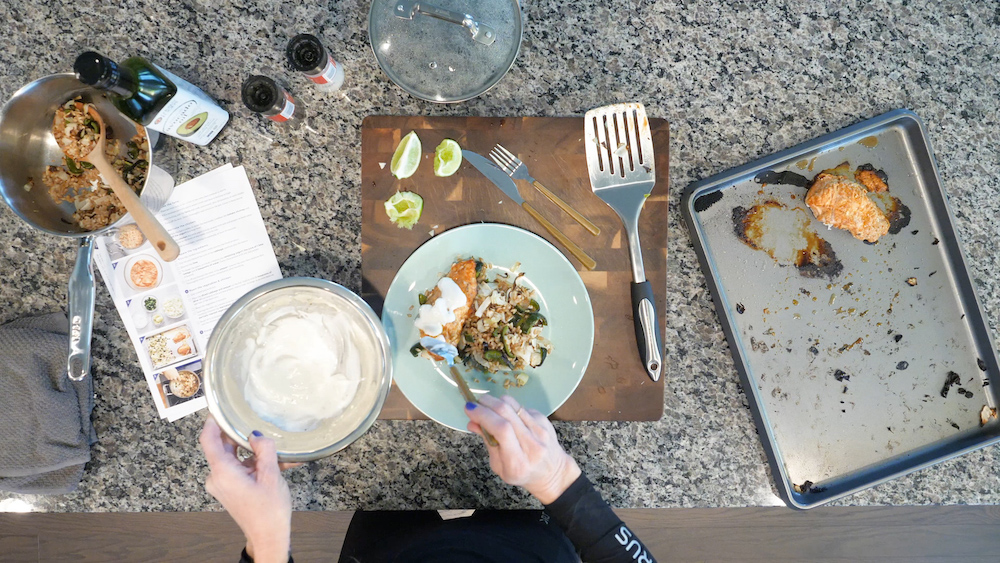
With convenience comes salt, and lots of it. Keep this in mind when stocking that pantry and freezer. Opt for frozen veggies without sauces or added flavorings, proteins without breading or marinades, and low-sodium or no-salt-added canned goods.
Benefits of High-Protein Recipes
Why is the “high protein” label so widely touted on food labels? Because you can’t build muscles without it. If you like to lift heavy things, you need to be lifting ample amounts of protein to your mouth on that fork. And even if the gym isn’t your thing, you want to make sure your muscles and mind have enough energy to go through your days successfully. Plus, protein tends to keep you fuller for longer.
Muscle Growth and Repair
Whether you engage in heavy lifting or just a lot of long walks with your dogs or kids, your muscles are taxed and stressed. Consuming adequate protein provides the amino acids necessary to repair muscle tissue and promote the synthesis or growth of new muscle fibers. So if you want to maintain and grow healthy muscles: lift heavy, live fully, eat protein. Rest. Repeat.
Satiety
It’s emotionally draining — to say the least — to be hungry, cranky, and limiting your calories. Especially when paired with healthy fats, foods high in protein provide more satiety than simple carbohydrates. Protein takes the body longer to digest and leaves you satisfied for an extended time.
Just look at all of the carby “100-calorie snack packs” you see at the grocery store register — there’s a reason why people tear through them and are still hungry a moment later. Protein is a solid ally if you are trying to stick to a caloric deficit but don’t want to feel that way.
[Related: Best Protein Shakes]
Blood Sugar Stabilization
Protein is just as important to consume before you lift or play that long game of catch with your kid as it is afterward. Eating protein in concert with carbohydrates and healthy fats helps to protect you from the blood sugar spikes that can leave you feeling sluggish and depleted, as it slows digestion and the absorption of carbohydrates.
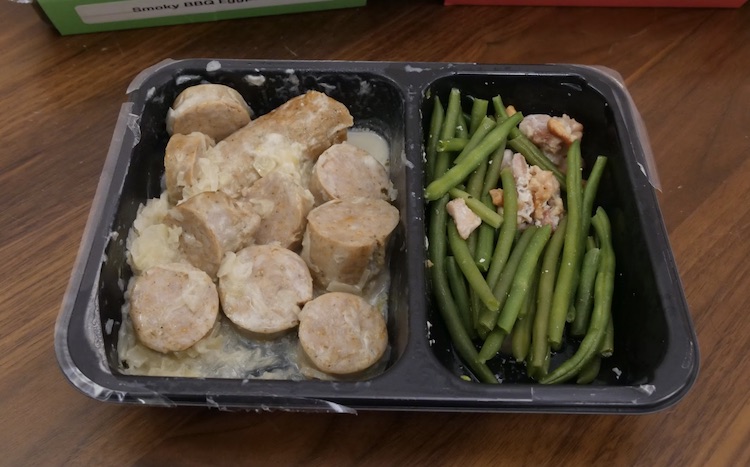
Nothing destroys motivation to dive into a workout faster than fatigue, so keep your energy levels stable throughout the day by incorporating protein into every meal or snack. Don’t just grab an apple; grab an apple and a cheese stick.
Get Cooking
You might be in the mood for take-out, but if you want to do your wallet a favor, try rummaging through those cabinets. It won’t take long to whip up a delicious, high-protein weeknight meal to help you refuel from the day and prepare for tomorrow.
Even if you swap out different veggies or proteins according to preference and availability, you can use these high-protein recipes as your baseline for nutritious dinners that won’t slam your wallet. Get to your goals in the gym by getting fueled up in the kitchen — without all the meticulous meal prep.
High-Protein Weeknight Recipes FAQs
What is a good high-protein and low-carb dinner?
Lining up protein-to-carb ratios and amounts, a fantastic high-protein, low-carb dinner is vegan sausage with greens and white beans. With a whopping 37 grams of protein and just 25 grams of carbs, it’s not the lowest-carb option out there, but it can help you keep an overall low-carb diet if that’s what you’re aiming for. In terms of individual foods, Greek yogurt, eggs, tofu, and nut butters are some of the best high-protein, low-carb foods out there.
What are the best sources of protein for dinner?
From tofu and tempeh to chicken and sustainably-sourced salmon, you’ve got a lot of options to choose from. These are all fantastic options for lean, complete sources of protein that will leave you full and your muscles well able to recover and even grow from the rigors of your regular day or strength training.
Is it important to eat high-protein dinners?
Eating high-protein dinners can definitely be an important part of an overall high-protein diet, especially if you’re trying to increase your protein intake. But, if you tend to eat dinner very late and it doesn’t agree with your digestive system, you might want to bias your protein intake toward the beginning of your days.
References
- Wempen, Kristi, RDN. (2022) Are You Getting Too Much Protein? Mayo Clinic Health System.
- A Building Block for Good Health: The Benefits of Protein. (2024) Atrium Health.
- Restivo, Jenette. (2023) High-Protein Foods: The Best Protein Sources to Include in a Health Diet. Harvard Health Publishing. Harvard Medical School.
- Wolfson JA, Bleich SN. Is cooking at home associated with better diet quality or weight-loss intention? Public Health Nutr. 2015 Jun;18(8):1397-406. doi: 10.1017/S1368980014001943. Epub 2014 Nov 17. PMID: 25399031; PMCID: PMC8728746.
- Wolfson JA, Leung CW, Richardson CR. More frequent cooking at home is associated with higher Healthy Eating Index-2015 score. Public Health Nutr. 2020 Sep;23(13):2384-2394. doi: 10.1017/S1368980019003549. Epub 2020 Jan 10. PMID: 31918785.